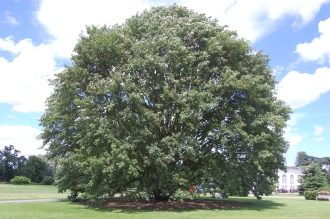
Quercus castaneifolia Acorns (30/07/2012, Kew Gardens, London)
Position: Sun to light shade
Flowering period: Spring
Soil: Moist, well drained
Eventual Height: 35m
Eventual Spread: 35m
Hardiness: 7a – 10a
Family: Fagaceae
Quercus castaneifolia is a fast growing, large deciduous tree. Its shiny dark green leaves are narrowly eliptic with serrate margins and up to 20cm long and 5cm broad. Its leaves turn bronze then brown before falling in autumn. Its horizontal branches grow from low down the tree trunk. Its trunk may achieve a diameter of 2.5m. Its bark. Its flowers are wind pollinated catkins. Its fruit are acorns which are up to 3cm long and 2cm broad.

Quercus castaneifolia (30/07/2012, Kew Gardens, London)
Quercus castaneifolia, commonly known as the Chestnut-leaved Oak, is native to the Caucasus and Iran. It was introduced into the UK in 1843.
The etymological root of the binomial name Quercus is derived from the Latin name for an Oak tree; some authorities derive the word from Celtic, quer, fine and cuez, a tree. Castaneifolia is derived from the Latin folium meaning ‘leaf’, and Castanea, in reference to this plants leaves being similar that of the Castanea genus.
The landscape architect may find Quercus castaneifolia useful as a large parkland tree, as this tree requires space.

Quercus castaneifolia Trunk (28/07/2012, Kew Gardens, London)
Ecologically, Q. castaneifolia acorns are eaten by birds and mammals.
The Royal Horticultural Society has given the variety Q. castaneifolia ‘Green Spire’ their prestigious Award of Garden Merit in 1993, this tree is more erect than the species.
Q. castaneifolia prefers moist, fertile, well-drained soils. It tolerates most pH of soil.
Quercus castaneifolia requires little maintenance.

